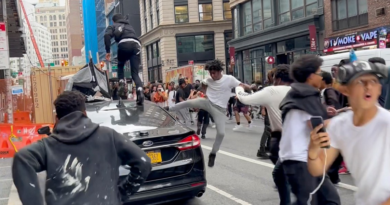The student loan forgiveness program is about to face a showdown before the Supreme Court
Whether or not tens of millions of student loan borrowers will receive $10,000 to $20,000 in forgiveness hinges on the outcome of two cases that the U.S. Supreme Court will start reviewing Tuesday.
Both cases challenge the legality of President Joe Biden’s widespread student loan forgiveness plan, one brought by two individuals and backed by a conservative advocacy group, and another brought by six conservative-led states (Arkansas, Iowa, Kansas, Missouri, Nebraska, and South Carolina).
Biden’s plan, announced in August, would eliminate up to $10,000 in federal student loan debt for borrowers earning under $125,000 per year (and under $250,000 for married couples). Those who received Pell Grants while in school and meet the same income requirements would be eligible for up to $20,000 in debt cancellation.
Conservatives and other opponents argue the Biden administration is overstepping its authority and that debt cancellation would need to be approved by Congress. They also say the program would set a dangerous precedent for presidential power: The government has never instituted such a widespread consumer debt forgiveness program before (though it has forgiven massive amounts of debt for banks and corporations), never mind without congressional approval. Estimates put the cost of the plan at around $400 billion.
Miguel Cardona, the U.S. secretary of education, used power stemming from the 2003 HEROES Act to implement the forgiveness measure. Under the HEROES Act, Cardona can change aspects of the federal student loan program during national emergencies if borrowers have “suffered direct economic hardship.”
The Supreme Court is considering two cases that challenge the legality of President Joe Biden’s widespread student loan forgiveness plan.
“The secretary has a responsibility to ensure that borrowers are not financially harmed from the pandemic,” says Persis Yu, deputy executive director at the Student Borrower Protection Center, which advocates for forgiveness. “The fact that student loan payments are looming over their shoulders is a source of anxiety for people.”
Who has standing?
Given that the Supreme Court has a 6–3 conservative majority that has been opposed to other broad government programs, financial experts say borrowers should not plan on the cancellation taking effect.
That said, the Biden administration and other experts are also arguing that the opposing sides in both student loan forgiveness cases do not have standing to sue at all.
In order to have standing, the original plaintiffs must show that they have suffered a tangible injury—for example, that the states suing would be made worse off financially if the forgiveness is implemented.
In Biden v. Nebraska, the attorney general of Missouri argues that MOHELA, a federal student loan servicer, would lose revenue if debt is forgiven. Because MOHELA is a quasi-state agency, he argues, that affects the state as a whole. MOHELA itself has not sued and has stayed largely quiet on the forgiveness effort.
Some legal experts, including two conservative economists who filed amicus briefs with the court, say this is not enough.
“Even if the executive branch has exceeded its authority…that does not permit the judicial branch to exceed its authority,” writes Samuel Bray of Notre Dame Law School and William Baude of the University of Chicago Law School.
In the other case, U.S. Department of Education v. Brown, two individuals are suing because they say they were deprived of procedural rights to weigh in on the plan before it was implemented. One of those individuals does not qualify for the program, and the other reportedly qualified for $10,000 in forgiveness but not $20,000. But because they wouldn’t be made worse off financially by the program, they do not have standing to sue, the Biden administration argues.
If the court finds that the plaintiffs do not have standing to sue, then they would not need to decide on the merits of the cases.
Borrowers “need relief”
Those are the big-picture questions at play. As the court proceedings begin, millions of borrowers are waiting to see what the outcome will be so that they can plan their financial futures.
Borrowers say the forgiveness would help them meet other financial goals, like saving for homes, and provide peace of mind. The ever-increasing costs of higher education—total student loan debt in the U.S. has surpassed $1.7 trillion—have made it more and more difficult for tens of millions of Americans to save for retirement, buy homes, get married, and have children. It’s also taken a toll on their mental health.
Yu says while the questions of standing and legality have taken center stage, it’s important to remember why the Biden administration used the authority of the HEROES Act in the first place: so that when federal student loan payments resume for 40 million people, they are not put in a precarious financial position.
The U.S. Department of Education has warned that student loan delinquencies and defaults will spike once the payment pause ends. And there’s never been any financial or national emergency the scale of the pandemic to contend with, says Yu.
“People have suffered really big consequences because of the pandemic…For too many people, unfortunately, things aren’t back to normal; they are still suffering,” she says. “This is a responsible way to end the payment pause while not harming borrowers financially.”
While the one-time forgiveness program would not solve America’s student debt crisis on its own, it could help an estimated 40 million borrowers at a time when inflation is stretching budgets thin.
“This is not a solution, Biden’s relief plan,” Andre Perry, a senior fellow at the Brookings Institution, previously told Fortune. “Ultimately, tuitions keep increasing. But to not do anything is ignoring a growing problem. Folks need relief.”
The White House said 26 million borrowers applied for forgiveness during the brief window applications were open last fall; 16 million were approved. If the Supreme Court does not halt the program, borrowers who did not apply yet should have another opportunity to do so.
Until the court decides—experts say that will come in May or June—federal student loan payments are still paused, as they have been for almost three years. The monthly bills will resume 60 days after the debt relief program is implemented or the litigation is otherwise resolved. At the latest, payments will resume Sept. 1, 2023, the Education Department said.
Learn how to navigate and strengthen trust in your business with The Trust Factor, a weekly newsletter examining what leaders need to succeed. Sign up here.




